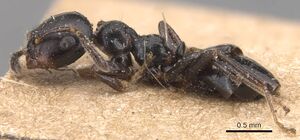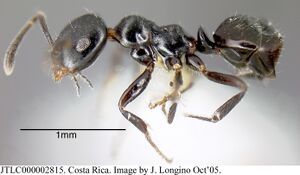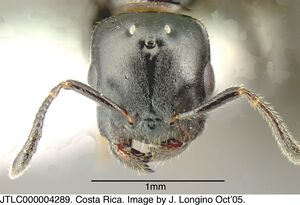Myrmelachista zeledoni
| Myrmelachista zeledoni | |
|---|---|

| |
| Scientific classification | |
| Kingdom: | Animalia |
| Phylum: | Arthropoda |
| Class: | Insecta |
| Order: | Hymenoptera |
| Family: | Formicidae |
| Subfamily: | Formicinae |
| Tribe: | Myrmelachistini |
| Genus: | Myrmelachista |
| Species: | M. zeledoni |
| Binomial name | |
| Myrmelachista zeledoni Emery, 1896 | |
| Synonyms | |
| |
In 1911 I found this species to be rather common in dead twigs at San Jose, Alajuela and Cartago, Costa Rica. Emery's type material came from the same region. (Wheeler 1934)
Identification
Longino (2006) - Worker black; antenna 10-segmented; face sericeous or shagreened, not shining.
Keys including this Species
- Key to Myrmelachista workers of Costa Rica
- Key to Myrmelachista queens of Costa Rica
- Key to Myrmelachista males of Costa Rica
Distribution
Latitudinal Distribution Pattern
Latitudinal Range: 19.1897222° to 8.783333333°.
| North Temperate |
North Subtropical |
Tropical | South Subtropical |
South Temperate |
- Source: AntMaps
Distribution based on Regional Taxon Lists
Neotropical Region: Colombia (type locality), Costa Rica, Guatemala, Honduras, Mexico, Nicaragua, Peru, Venezuela.
Distribution based on AntMaps
Distribution based on AntWeb specimens
Check data from AntWeb
Countries Occupied
| Number of countries occupied by this species based on AntWiki Regional Taxon Lists. In general, fewer countries occupied indicates a narrower range, while more countries indicates a more widespread species. |

|
Estimated Abundance
| Relative abundance based on number of AntMaps records per species (this species within the purple bar). Fewer records (to the left) indicates a less abundant/encountered species while more records (to the right) indicates more abundant/encountered species. |

|
Biology
Longino (2006) - This is a montane species that occurs at mid-elevation, from 600-1500m. It is found throughout Costa Rica it is most abundant in seasonally dry to moist forest habitat and less common in cloud forest and very wet forest. It also seems more abundant in disturbed habitats than in mature forest It does well in synanthropic habitats, being common in the Central Valley and in scrubby forest on the Pacific slope in and below Monteverde.
Nests are usually in dead stems of trees, often in relatively hard wood, and usually high in the tree or otherwise highly insolated areas. Nests occasionally occur in live stems; I have collected nests from live stems of Cecropia angustifolia, Hampea appendiculata, and an unidentified lauraceous tree. It usually appears that they opportunistically use preexisting cavities rather than excavating their own. Colonies are often large and polydomous, occurring in many dead branches of multiple adjacent trees. Incipient colonies are monogynous in small dead or live stems.
Workers are diurnal foragers and may be found scattered on foliage and branch surfaces. In the field they look remarkably similar to Crematogaster and may even elevate the gaster when disturbed.
Association with Other Organisms
 Explore: Show all Associate data or Search these data. See also a list of all data tables or learn how data is managed.
Explore: Show all Associate data or Search these data. See also a list of all data tables or learn how data is managed.
This species is a host for the strepsipteran Caenocholax fenyesi (a parasite) (Cook, 2019).
Castes
Worker
Images from AntWeb
   
| |
| Syntype of Myrmelachista zeledoni. Worker. Specimen code casent0905167. Photographer Will Ericson, uploaded by California Academy of Sciences. | Owned by MSNG, Genoa, Italy. |
   
| |
| Syntype of Myrmelachista zeledoni thiemei. Worker. Specimen code casent0905168. Photographer Will Ericson, uploaded by California Academy of Sciences. | Owned by MSNG, Genoa, Italy. |
  
| |
| Queen (alate/dealate). Specimen code jtlc000002815. Photographer J. Longino, uploaded by University of Utah. | Owned by JTLC. |
Queen
Images from AntWeb
 
| |
| Queen (alate/dealate). Specimen code jtlc000004289. Photographer J. Longino, uploaded by University of Utah. | Owned by JTLC. |
Male
Images from AntWeb

| |
| Male (alate). Specimen code inbiocri001280739. Photographer J. Longino, uploaded by University of Utah. | Owned by JTLC. |
Nomenclature
The following information is derived from Barry Bolton's Online Catalogue of the Ants of the World.
- zeledoni. Myrmelachista zeledoni Emery, 1896g: 102 (w.) COLOMBIA. Wheeler, W.M. 1934g: 203 (m.); Wheeler, G.C. & Wheeler, J. 1953c: 138 (l.); Longino, 2006a: 47 (q.). Combination in M. (Decamera): Emery, 1925b: 33; in M. (Hincksidris): Kempf, 1972a: 150. Senior synonym of thiemei: Longino, 2006a: 47.
- thiemei. Myrmelachista zeledoni var. thiemei Emery, 1906c: 185 (footnote) (w.) VENEZUELA. Junior synonym of zeledoni: Longino, 2006a: 47.
Unless otherwise noted the text for the remainder of this section is reported from the publication that includes the original description.
Description
Worker
Longino (2006) - HL 0.521–0.720, HW 0.506–0.708, SL 0.364–0.472, EL 0.113–0.169, CI 92–100 (n=5).
Antenna 10-segmented; maxillary palpus 6-segmented; mandible smooth to feebly rugose; clypeus somewhat roughened; most of face with fine striate microsculpture giving a silky luster, grading to smooth and shiny on vertex margin; sides, rear margin and ventral surface of head with sparse, short, appressed pubescence, no erect setae; scapes with abundant suberect setae, longer setae about 1/2 scape width; hind tibia with abundant subdecumbent setae, longer setae about 1/4 width of tibia; mesosoma strongly constricted at metanotal groove, hourglass-shaped; entire mesosoma with reticulate microsculpture, matte; petiole in side view with compressed, scale-like node; color solid black. Also see description of Emery (1896).
Queen
Longino (2006) - HL 0.904–1.031, HW 0.836–0.939, SL 0.465–0.534, EL 0.267–0.323, OW 0.061–0.080, OD 0.206–0.237, CI 90–92, OI 32–35, OcI 7–8 (n=5).
Similar to worker in meristic characters, patterns of sculpture, pilosity, coloration. Labrum short, bilobed.
Male
Wheeler (1934) - Length 2.4 mm.
Head without the mandibles decidedly broader than long, broad and semicircularly rounded behind, with large eyes and prominent ocelli, much narrowed in front, with straight, anteriorly converging cheeks. Mandibles well developed, with two large teeth. Clypeus very convex but not carinate in the middle, its anterior border broadly rounded and projecting. Antennae 11-jointed, long; scapes reaching to the posterior ocelli; first funicular joint small, as broad as long; remaining joints decidedly longer than broad. Thorax robust, broader than the head; mesonotum broader than long, convex and hemispherically rounded anteriorly; epinotum small, scarcely convex, sloping, without differentiated base and declivity. Petiole small, nodiform, conical in profile, with blunt, entire, convex and rounded superior border. Gaster rather large, with large, exserted genitalia. Legs long and slender. Wings long, with a single elongate cubital and no discoidal cell.
Smooth and shining; pilosity consisting of a few short, erect hairs on the clypeus, thorax and gaster; pubescence undeveloped. Brown; head, mesopleurre and outer genital valves darker, castaneous; mandibles, clypeus, antennre and legs brownish yellow; sagittae whitish; wings grayish, with pale brown veins and pterostigma.
Longino (2006) - Antenna 11-segmented; maxillary palpus 6-segmented; pygostyles present, sclerotized, setose; basiparamere lobe and paramere short, robust, broadly triangular; cuspis robust, spatulate, with an apicodorsal field of small teeth at the apical contact point with the digitus; digitus short, dorsal margin forming an abrupt right angle, apex of digitus a ventrally directed triangular lobe; penial valve short and broad, apex blunt, with dorsally-directed short triangular tooth, apodeme of penial valve strongly developed, at right angle to the rest of valve.
Type Material
Syntype workers: San José, Costa Rica (Alfaro) Museo Civico di Storia Naturale, Genoa (examined).
References
- Cook, J.L. 2019. Annotated catalog of the order Strepsiptera of the world. Transactions of the American Entomological Society 144: 121-267 (doi:10.3157/061.145.0202).
- Emery, C. 1896g. Studi sulle formiche della fauna neotropica. XVII-XXV. Bull. Soc. Entomol. Ital. 28: 33-107 (page 102, worker described)
- Emery, C. 1925d. Hymenoptera. Fam. Formicidae. Subfam. Formicinae. Genera Insectorum 183: 1-302 (page 33, Combination in M. (Decamera))
- Kempf, W. W. 1972b. Catálogo abreviado das formigas da regia~o Neotropical. Stud. Entomol. 15: 3-344 (page 150, Combination in M. (Hincksidris))
- Longino, J.T. 2006. A taxonomic review of the genus Myrmelachista in Costa Rica. Zootaxa. 1141:1-54.
- Wheeler, G. C.; Wheeler, J. 1953c. The ant larvae of the subfamily Formicinae. Ann. Entomol. Soc. Am. 46: 126-171 (page 138, larva described)
- Wheeler, W. M. 1934g. Neotropical ants collected by Dr. Elisabeth Skwarra and others. Bulletin of the Museum of Comparative Zoology 77: 157-240 (page 203, male described)
References based on Global Ant Biodiversity Informatics
- Bezdeckova K., P. Bedecka, and I. Machar. 2015. A checklist of the ants (Hymenoptera: Formicidae) of Peru. Zootaxa 4020 (1): 101–133.
- Dattilo W. et al. 2019. MEXICO ANTS: incidence and abundance along the Nearctic-Neotropical interface. Ecology https://doi.org/10.1002/ecy.2944
- Fernández, F. and S. Sendoya. 2004. Lista de las hormigas neotropicales. Biota Colombiana Volume 5, Number 1.
- Kempf, W.W. 1972. Catalago abreviado das formigas da regiao Neotropical (Hym. Formicidae) Studia Entomologica 15(1-4).
- Longino J. T. 2006. A taxonomic review of the genus Myrmelachista (hymenoptera: Formicidae) in Costa Rica. Zootaxa 1141: 1-54
- Longino J. et al. ADMAC project. Accessed on March 24th 2017 at https://sites.google.com/site/admacsite/
- Wheeler W. M. 1934. Neotropical ants collected by Dr. Elisabeth Skwarra and others. Bulletin of the Museum of Comparative Zoology 77: 157-240.

